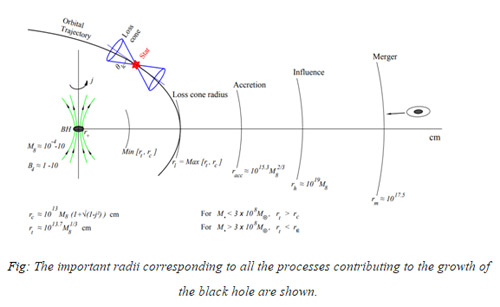 All massive galaxies have super-massive black holes (SMBHs) at their centers. At their centre, stellar or gas motions are dominated by the gravitational potential of the SMBH. Black holes (BHs) grow their mass and spin by accretion of gas, the capture of stars, and by the merger activity of galaxies (that include the central BHs) while the electromagnetic torque drives a powerful jet from the BH drawing from its rotational energy and causing a spin-down of the hole. These processes constitute the evolution model of the central BH. The connection of the SMBHs to their host galaxies is evidenced by the strong correlation between the mass of SMBH (M•) and velocity dispersion (σ) of the stars in the rest of the galaxy, far from the BH.
All massive galaxies have super-massive black holes (SMBHs) at their centers. At their centre, stellar or gas motions are dominated by the gravitational potential of the SMBH. Black holes (BHs) grow their mass and spin by accretion of gas, the capture of stars, and by the merger activity of galaxies (that include the central BHs) while the electromagnetic torque drives a powerful jet from the BH drawing from its rotational energy and causing a spin-down of the hole. These processes constitute the evolution model of the central BH. The connection of the SMBHs to their host galaxies is evidenced by the strong correlation between the mass of SMBH (M•) and velocity dispersion (σ) of the stars in the rest of the galaxy, far from the BH.Researchers from the Indian Institute of Astrophysics (IIA), Bangalore, an autonomous institute of the Department of Science & Technology, Government of India, have modeled the evolution of this relation which can help building demographics of the BHs and scenarios involving stellar capture.
The study on cosmic spin and mass evolution of black holes by D. Bhattacharyya and A. Mangalam, from IIA which has been published in the Astrophysical Journal, 2020 can help chalk out black hole archaeology, where one can look into the past and redraw the black hole properties at the formation from the present-day values as initial conditions, and also estimate SMBH seed properties at formation from stellar-mass black holes via the stellar capture process.
The key novel aspects of the model are the relativistic inputs to the stellar capture theory (stars can get tidally disrupted or can get directly captured depending on the mass of the BH), and including all known contributions of gas, stellar, electromagnetic torque, and mergers in detail for calculating the evolution. Each effect is included individually, before finally deriving the complete evolution. The model gives important insights into black hole physics and galactic structure, as the study of the evolution of BHs and the M• − σ relations are very important from both theoretical and observational points of view.
While the BH grows its mass, the gas accretion process stops after it reaches a saturated mass due to a feedback of the luminosity on the infalling gas. Before saturation, accretion dominates the growth, and subsequently, stellar capture and mergers take over with roughly equal contributions. For stellar capture, a power-law in stellar density in the cusp around the black hole was assumed in a relativistic framework. The IIA team assumed the merger activity effective for redshift less than 4, and the electromagnetic torque, which contributes to the spin-down process, is included self-consistently. The calculations involving both symbolic and numeric operations were performed using the High-performance computing facility of IIA.
The model of the joint evolution of BH mass, spin, and M•–σ relation developed by IIA researchers throw light on the co-evolution of the BH and its environment from the time of formation. It is expected that this transparent and detailed formulation in a fully relativistic theory will be useful for future simulation studies for building demographics of the BHs and information scenarios involving stellar capture.
For more details, Prof. Arun Mangalam (mangalam[at]iiap[dot]res[dot]in) can be contacted.






























